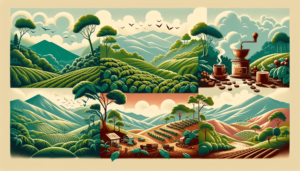Coffee lovers unite! If you’re as obsessed with that morning cup of joe as we are, then you’re in for a treat. Today, we’re diving into the fascinating world of coffee-growing regions and exploring the unique qualities that set them apart. From the lush mountains of Ethiopia to the volcanic soil of Costa Rica, we’ll take you on a journey through the top coffee-growing regions in the world. So grab your favorite mug, settle in, and get ready to discover the coffee flavors that will transport you to far-flung corners of the globe.

The Top Coffee-Growing Regions and Their Unique Qualities
Coffee is one of the most beloved beverages in the world, and its popularity continues to grow. From the moment we wake up to the late afternoon pick-me-up, coffee plays an integral part in our daily lives. But have you ever wondered where your favorite cup of coffee comes from? There are several regions around the world known for producing exceptional coffee beans with unique qualities. Let’s take a closer look at some of the best coffee-growing regions and what sets their coffee apart.
1. African Region
Ethiopia
Ethiopia is often referred to as the birthplace of coffee, and its coffee industry has a rich history. Ethiopian coffee is renowned for its fruity and floral flavors, which are a result of the country’s unique coffee-growing conditions. The high altitudes, fertile soil, and ideal climate contribute to the development of complex flavor profiles. Each sip of Ethiopian coffee provides a delightful experience with its vibrant citric acidity and sweet floral aroma.
Kenya
Kenyan coffee is highly regarded in the specialty coffee industry for its exceptional quality and distinctive taste. The country’s volcanic soil and ideal climate create the perfect conditions for growing high-quality coffee beans. Known for its bright acidity and rich complexity, Kenyan coffee offers a unique flavor profile that often includes notes of blackcurrant, citrus, and wine-like acidity. It is a true delight for coffee connoisseurs seeking a flavorful and vibrant cup.
Tanzania
Tanzanian coffee may not be as well-known as its Ethiopian and Kenyan counterparts, but it certainly holds its ground when it comes to quality. The coffee beans grown in Tanzania are characterized by their mild and clean taste, making them a favorite among coffee enthusiasts looking for a balanced cup. With medium acidity and subtle flavor notes of chocolate, citrus, and nuts, Tanzanian coffee offers a smooth and enjoyable drinking experience.
2. South American Region
Brazil
Brazil is the largest coffee producer in the world, and its coffee industry plays a significant role in the global coffee market. Brazilian coffee is known for its nutty and chocolaty flavor profiles, making it a popular choice for those who prefer a smooth and well-balanced cup. The main reason behind Brazil’s dominance in the coffee industry is its vast coffee-growing regions, suitable climate, and the use of modern farming techniques, resulting in consistent quality and flavor.
Colombia
Colombian coffee has gained a reputation for its high quality and distinct characteristics. The country’s diverse microclimates, ranging from mountainous regions to valleys, contribute to the unique flavors found in Colombian coffee. With a well-balanced and medium-bodied profile, Colombian coffee offers a harmonious combination of caramel sweetness, nuttiness, and a hint of fruity acidity. It’s no wonder Colombian coffee is favored by coffee lovers worldwide.
Costa Rica
Costa Rican coffee is celebrated for its bright acidity and sweet aroma, making it a popular choice among those seeking a refreshing and aromatic cup of coffee. The country’s rich volcanic soil and high altitudes create optimal conditions for growing coffee beans with excellent flavor profiles. Costa Rican coffee often exhibits notes of citrus, berry, and chocolate, providing a delightful drinking experience with a well-rounded and clean taste.
3. Central American Region
Guatemala
Guatemala has emerged as one of the top coffee-producing countries in Central America, known for its high-quality Arabica coffee beans. The country’s volcanic soil, coupled with the ideal altitude and climate, contributes to the development of rich and complex flavors. Guatemalan coffee is distinguished by its bright acidity, full body, and a wide range of flavor notes, including chocolate, caramel, and fruit. It’s no wonder that coffee enthusiasts appreciate the unique characteristics of Guatemalan coffee.
Honduras
Honduras has rapidly grown as a coffee-producing nation, attracting attention for its high-quality coffee beans. The diverse microclimates and altitude variations in Honduras result in a wide array of flavor profiles. Honduran coffee typically offers a medium body, balanced acidity, and a mix of sweet and nutty flavors. With tasting notes that may include chocolate, caramel, and citrus, Honduran coffee provides a delightful cup that appeals to a wide range of coffee aficionados.
Mexico
Mexico may not be the first country that comes to mind when thinking of coffee, but it has a rich coffee culture and produces some exceptional beans. Mexican coffee is known for its smooth and well-rounded flavor profiles, often characterized by medium body, mild acidity, and a pleasant aroma. With notes of chocolate, nuts, and floral undertones, Mexican coffee offers a comforting and flavorful drinking experience.

4. Asian Region
Indonesia
Indonesia is renowned for its unique coffee varieties, with the most famous being Sumatran coffee. Indonesian coffee is often known for its complex and earthy flavor profiles that set it apart from other coffee regions. The country’s rich volcanic soil, tropical climate, and traditional processing methods contribute to the development of unique flavors. Indonesian coffee typically exhibits low acidity, full body, and may have tasting notes of dark chocolate, cedar, and spices.
Vietnam
Vietnam is the second-largest coffee producer globally, specializing in the production of Robusta coffee beans. While Robusta beans are often associated with lower quality, Vietnamese coffee has gained recognition for its unique flavor profiles. Vietnamese coffee is known for its strong and robust characteristics, often showcasing a bittersweet taste with notes of dark chocolate and nuts. The country’s traditional method of brewing coffee using a phin filter also adds an interesting cultural aspect to the coffee experience.
India
India may not be as well-known for its coffee as its tea, but it still produces some remarkable beans. Indian coffee is predominantly grown in the southern regions of the country, benefiting from the rich biodiversity and favorable climate. Indian coffee often exhibits a wide range of flavors, depending on the region and variety. From fruity and floral to spicy and nutty, the flavors found in Indian coffee can be diverse and intriguing, offering a unique experience to coffee enthusiasts.
5. Caribbean Region
Jamaica
Jamaican coffee, particularly the Blue Mountain variety, is considered one of the most premium and sought-after coffees in the world. The Blue Mountains of Jamaica provide the ideal conditions for growing coffee, with high altitudes and a tropical climate. Jamaican coffee is known for its smooth and mellow flavors, featuring a delicate balance of acidity and sweetness. With notes of chocolate, nuts, and spices, Jamaican coffee offers a luxurious drinking experience.
Dominican Republic
The Dominican Republic has a long history of coffee production and is known for its high-quality Arabica beans. The country’s unique combination of fertile soil, mountainous topography, and cool climate contributes to the development of distinct flavors in Dominican coffee. Dominican coffee typically offers a medium to full body, balanced acidity, and flavors that range from chocolate and nuts to floral and fruity notes, providing a delightful cup for coffee lovers to savor.
Haiti
Haitian coffee may be lesser-known compared to its Caribbean counterparts, but it still holds its own when it comes to flavor and quality. The mountainous regions of Haiti provide excellent conditions for coffee growing, resulting in beans with unique characteristics. Haitian coffee is often described as having a smooth and medium body, accompanied by a mild and pleasant acidity. With flavors that may include chocolate, caramel, and tropical fruit, Haiti offers a taste of the Caribbean that shouldn’t be missed.

6. Pacific Region
Hawaii
Hawaiian coffee, particularly Kona coffee, is esteemed for its exceptional quality and distinctive taste. The volcanic soil and unique microclimates of Hawaii’s Kona region provide the perfect environment for growing coffee beans with complex flavors. Kona coffee is known for its medium acidity, smooth and velvety mouthfeel, and a diverse range of tasting notes. From hints of caramel and nuts to floral and fruity undertones, Hawaiian coffee offers a luxurious and enjoyable coffee experience.
Papua New Guinea
Papua New Guinea may not be as well-known as some other coffee-growing regions, but it produces coffee beans with unique qualities. The country’s rich volcanic soil, tropical climate, and high altitudes contribute to the development of fascinating flavor profiles in Papua New Guinean coffee. With medium acidity and a range of flavor notes that may include chocolate, berries, and spices, Papua New Guinean coffee offers a distinct and flavorful cup that surprises and delights.
Vanuatu
Vanuatu, a small island nation in the South Pacific, may not be on everyone’s radar when it comes to coffee, but it has its own unique offerings. Coffee production in Vanuatu is still quite small scale, but the country’s volcanic soil and favorable climate result in coffee beans with distinct flavors. Vanuatu coffee often exhibits medium acidity, a smooth body, and flavors that can range from chocolate to tropical fruits, providing a pleasant and intriguing coffee experience.
7. European Region
Italy
Italy is renowned for its strong coffee culture and the art of espresso. Italian coffee is characterized by its bold and intense flavor, often associated with dark roasts and a rich crema. Italian espresso is the foundation of many coffee-based beverages, with its strong and robust flavor providing a robust kick. Italian coffee is typically enjoyed in small portions, emphasizing the intensity of flavor and the unique coffee experience it offers.
Spain
Coffee holds a special place in Spanish culture, with café culture being an integral part of daily life. Spanish coffee is known for its dark roast profiles and strong flavors. While Spanish coffee is often consumed as espresso, it is also popular to enjoy it as a café con leche, which is coffee with hot milk. Spanish coffee provides a bold and full-bodied taste, often accompanied by notes of chocolate and spices, offering a rich and satisfying drinking experience.
Portugal
Portuguese coffee is deeply ingrained in the country’s cultural fabric, with coffee houses (cafés) being an integral part of Portuguese daily life. Portuguese coffee is characterized by its strong and aromatic qualities, often roasted dark for a flavorful experience. Traditional Portuguese coffee is typically enjoyed as a bica, the Portuguese equivalent of an espresso, with its bold flavor and rich crema. Portuguese coffee offers a taste of tradition and cultural heritage, providing a unique and memorable coffee experience.
In conclusion, the world is abundant with coffee-growing regions, each offering its own unique qualities and flavors. Whether it’s the fruity and floral notes of Ethiopian coffee, the nutty and chocolaty profiles of Brazilian coffee, or the bold and intense espresso culture of Italy, coffee lovers are spoilt for choice. Exploring the diverse coffee-growing regions allows us to appreciate the nuances and differences in taste, providing a deeper understanding and enjoyment of one of our favorite beverages. So, next time you savor your cup of coffee, take a moment to think about the region it comes from and the journey it has taken to reach your mug.


